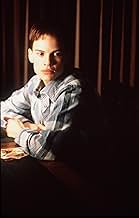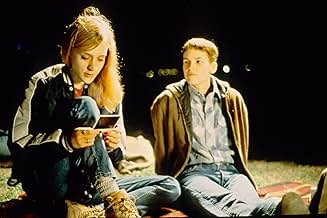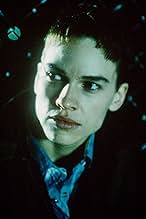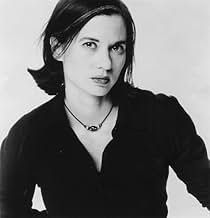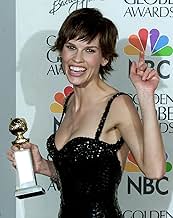Ein junger Mann namens Brandon Teena navigiert sich im ländlichen Nebraska durch Liebe, Leben und Transgender.Ein junger Mann namens Brandon Teena navigiert sich im ländlichen Nebraska durch Liebe, Leben und Transgender.Ein junger Mann namens Brandon Teena navigiert sich im ländlichen Nebraska durch Liebe, Leben und Transgender.
- 1 Oscar gewonnen
- 50 Gewinne & 39 Nominierungen insgesamt
Lisa Renee Wilson
- Pam
- (as Lisa Wilson)
Handlung
WUSSTEST DU SCHON:
- WissenswertesWhen Hilary Swank was living as a man to prepare for the role of Brandon Teena, her neighbors believed that the young man coming and going from Swank's home (Swank in male character) was her visiting brother.
- PatzerNear the beginning of the movie when Brandon's wallet spills to the floor, his license clearly is an Iowa driver's license. Yet towards the end after the rape scene, Brandon tells Lani she has never left Lincoln, Nebraska. In fact, it is common for fake ids (which Brandon has) to be out-of-state ids, since this makes authentication more difficult.
- Crazy CreditsA special thanks to all of the transmen and butch dykes who helped, advised and auditioned for this project and supported the process of bringing this story to the screen.
- Alternative VersionenThe USA version originally garnered an NC-17 from the MPAA. The film was cut and re-rated R. The European version reportedly is uncut.
- SoundtracksJust What I Needed
Written by Ric Ocasek
Performed by The Cars
Published by Lido Music, Inc.
Courtesy of Elektra Entertainment Group
By Arrangement with Warner Special Products
Ausgewählte Rezension
(Note: Over 500 of my movie reviews are now available in my book "Cut to the Chaise Lounge or I Can't Believe I Swallowed the Remote!" Get it at Amazon.)
This movie really made me think about sexual differences and what it means to have a sex change or to want one, or to be trapped in a gender you don't want. It was very effective to have us see Hilary Swank (who plays Brandon Teena/Teena Brandon) with short hair and male facial expressions and gestures without giving us a glimpse of her as Teena. (Actually we did get a brief glimpse in a photo.) Swank looks like a boy, acts like a boy, in fact works hard to be a boy; indeed that is (sadly) part of what this movie is about, what it means to be a boy in middle America as opposed to being a girl. And then when we have the scene with the tampons and the breast wrapping and we see her legs, the effect is startling, an effect possibly lost on those who knew that the person playing Brandon was a woman. It was when I saw her legs and could tell at a glance that she was a woman with a woman's legs that I realized just how subtle, but unmistakable are the anatomical sexual differences, and how convincing Swank's portrayal was.
I was reminded as I watched this of being a young person, of being a teenager and going through all the rituals and rites, unspoken, unplanned, without social sanction, that we all go through to prove our identity, because that is what Brandon was so eager to do, to prove his identity as a boy. I thought, ah such an advantage he has with the girls because he knows what they like and what they want. He can be smooth, and how pretty he looks. It was strange. I actually knew some guys in my youth who had such talent, and the girls did love them.
The direction by Kimberly Peirce is nicely paced and the forebodings of horror to come are sprinkled lightly throughout so that we don't really think about the resolution perhaps until the campfire scene in which John Lotter shows his self-inflicted scars and tosses the knife to Brandon. Then we know for sure, something bad is going to happen.
Hilary Swank is very convincing. Her performance is stunning, and she deserved the Academy Award she won for Best Actress. She is the type of tomboy/girl so beloved of the French cinema, tomboyish, but obvious a girl like, for example, Zouzou as seen in Chloe in the Afternoon (1972) or Élodie Bouchez in the The Dreamlife of Angels (1998), or many others. Indeed, one is even reminded of Juliette Binoche, who of course can play anything, or going way back, Leslie Caron in Gigi (1958). Chloe Signvey, who plays Lana Tisdel, the girl Brandon loves, whom I first saw in Palmetto (1998), where she stole a scene or two from Woody Allen and Elisabeth Shue, really comes off ironically as butch to Swank, yet manages a sexy, blue collar girl next door femininity. She also does a great job. Peter Sarsgaard is perfect as John Lotter, trailer trash car thief and homophobic redneck degenerate.
Very disturbing is the ending. If you know the story, you know the ending. Just how true this was to the real life story it is based on is really irrelevant. I knew nothing about the story, but I know that film makers always take license to tell it the way they think it will play best, and so it's best to just experience the film as the film, independent of the real story, which, like all real stories, can never be totally told.
Obviously this is not for the kiddies and comes as close to an "X" rating as any "R" movie you'll ever see. It will make most viewers uncomfortable, but it is the kind of story that needs to be told.
This movie really made me think about sexual differences and what it means to have a sex change or to want one, or to be trapped in a gender you don't want. It was very effective to have us see Hilary Swank (who plays Brandon Teena/Teena Brandon) with short hair and male facial expressions and gestures without giving us a glimpse of her as Teena. (Actually we did get a brief glimpse in a photo.) Swank looks like a boy, acts like a boy, in fact works hard to be a boy; indeed that is (sadly) part of what this movie is about, what it means to be a boy in middle America as opposed to being a girl. And then when we have the scene with the tampons and the breast wrapping and we see her legs, the effect is startling, an effect possibly lost on those who knew that the person playing Brandon was a woman. It was when I saw her legs and could tell at a glance that she was a woman with a woman's legs that I realized just how subtle, but unmistakable are the anatomical sexual differences, and how convincing Swank's portrayal was.
I was reminded as I watched this of being a young person, of being a teenager and going through all the rituals and rites, unspoken, unplanned, without social sanction, that we all go through to prove our identity, because that is what Brandon was so eager to do, to prove his identity as a boy. I thought, ah such an advantage he has with the girls because he knows what they like and what they want. He can be smooth, and how pretty he looks. It was strange. I actually knew some guys in my youth who had such talent, and the girls did love them.
The direction by Kimberly Peirce is nicely paced and the forebodings of horror to come are sprinkled lightly throughout so that we don't really think about the resolution perhaps until the campfire scene in which John Lotter shows his self-inflicted scars and tosses the knife to Brandon. Then we know for sure, something bad is going to happen.
Hilary Swank is very convincing. Her performance is stunning, and she deserved the Academy Award she won for Best Actress. She is the type of tomboy/girl so beloved of the French cinema, tomboyish, but obvious a girl like, for example, Zouzou as seen in Chloe in the Afternoon (1972) or Élodie Bouchez in the The Dreamlife of Angels (1998), or many others. Indeed, one is even reminded of Juliette Binoche, who of course can play anything, or going way back, Leslie Caron in Gigi (1958). Chloe Signvey, who plays Lana Tisdel, the girl Brandon loves, whom I first saw in Palmetto (1998), where she stole a scene or two from Woody Allen and Elisabeth Shue, really comes off ironically as butch to Swank, yet manages a sexy, blue collar girl next door femininity. She also does a great job. Peter Sarsgaard is perfect as John Lotter, trailer trash car thief and homophobic redneck degenerate.
Very disturbing is the ending. If you know the story, you know the ending. Just how true this was to the real life story it is based on is really irrelevant. I knew nothing about the story, but I know that film makers always take license to tell it the way they think it will play best, and so it's best to just experience the film as the film, independent of the real story, which, like all real stories, can never be totally told.
Obviously this is not for the kiddies and comes as close to an "X" rating as any "R" movie you'll ever see. It will make most viewers uncomfortable, but it is the kind of story that needs to be told.
- DennisLittrell
- 16. Sept. 2001
- Permalink
Top-Auswahl
Melde dich zum Bewerten an und greife auf die Watchlist für personalisierte Empfehlungen zu.
Details
- Erscheinungsdatum
- Herkunftsland
- Offizieller Standort
- Sprache
- Auch bekannt als
- Take It Like a Man
- Drehorte
- Greenville, Texas, USA(Courthouse scene)
- Produktionsfirmen
- Weitere beteiligte Unternehmen bei IMDbPro anzeigen
Box Office
- Budget
- 2.000.000 $ (geschätzt)
- Bruttoertrag in den USA und Kanada
- 11.540.607 $
- Eröffnungswochenende in den USA und in Kanada
- 73.720 $
- 10. Okt. 1999
- Weltweiter Bruttoertrag
- 11.540.607 $
- Laufzeit1 Stunde 58 Minuten
- Farbe
- Sound-Mix
- Seitenverhältnis
- 1.85 : 1
Zu dieser Seite beitragen
Bearbeitung vorschlagen oder fehlenden Inhalt hinzufügen



